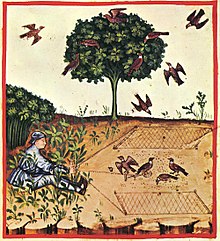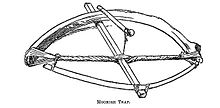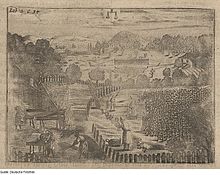Bird trap

A bird trap is a trap for catching wild birds . In the past, bird hunting was generally used to acquire food , later also to catch house birds in the wild .
Today bird trapping in Europe has only traditional reasons and it is banned in most regions due to the European Birds Directive . The following bird traps are still in use in Europe.
Hitting iron
The devices, also known as hoop traps or snap traps, work like a mousetrap, but with two straps. They are similar to leghold traps , but are made of wood or wire. The brackets close by coil springs or, as in the picture, by a taut arch with twisted cords as soon as a bird takes the load off the stick that is holding the bracket taut by sitting on it and releases it from its lock (e.g. a small noose). The birds are z. B. lured by a living mealworm as bait and killed with the clapping stirrups. Chisels are banned all over Europe - but are used illegally on the entire Mediterranean coast and in the Southern Alps .
Bow traps
Bow traps exist z. B. from a hazelnut rod, which is held under tension with a cord: part of the cord is clamped with a small stick, the rest forms a loop. Birds attracted by red baitberries - mostly small songbirds such as wrens and robins - are tempted to sit on the stick. As soon as the bird settles there, the tension on the tail is released and the animal's legs get caught in the noose. The bird lives on with its legs entwined and stays fresh until the bird catcher arrives. Bow traps were once widespread in Europe, today they are banned everywhere and, according to bird protection organizations, are only in use in an area of 1,500 square kilometers in the northern Italian province of Brescia ( Lombardy ).
Horsehair loops ("Dohnenstiege")
Unlike a gallows , horsehair loops consist of a tightening loop made of horsehair - nowadays partly made of synthetic fibers. The loops are attached to tree trunks or on the ground with a fixed rod and are provided with red bait berries. The lured birds - mostly thrushes and robins - get caught in the snare more or less by chance when looking for the berries, flee (forwards) and are thus strangled ("strangled"). Horsehair loops - also known as Dohnenstiege - were widespread throughout Europe until the 19th century and can still be found in southern Sweden , northern France ( Ardennes ), the central Apennines (Italy) and Sardinia . France has legalized the use of snares, everywhere else they are banned.
Liming rods
Rods coated with glue were used to catch birds as early as the Stone Age. In the past, the sticky mass was made from the berries of mistletoe , today almost only synthetically produced glue is used. Usually branches are coated with the colorless and odorless mass and positioned around berry bushes or decoy cages. If the stuck wild birds are freed quickly, they are often unharmed and are then often used as decoys - if they are left hanging on the tail for too long, they die and are eaten. Liming rods are still used today in southern France, Spain, Italy and Cyprus. This method is allowed in Spain and banned in France in 2021.
Safety nets
Catch nets or Japanese nets are wafer-thin fabrics made of nylon that are set up in thick bushes or against a dark background. The birds do not see the net, especially at dusk, and within seconds they get so tangled that they can no longer escape. If the net was set up to catch live birds (e.g. to attract decoys or housebirds), the animals can be rescued alive if the net is checked frequently. If the birds stay in the net for several hours, they usually strangle themselves and die. Nets should be banned everywhere due to the EU bird protection directive, but Italy, France and Spain in particular repeatedly approve their use. In many places in the Mediterranean and the Benelux countries, fishing nets are also illegally set up.
Falling rocks

Stone Age method by which birds are killed using a large stone slab. Lured by berries, the birds - usually thrushes, robins and titmice - look for food under the stone or wooden plate set up with wooden sticks (see illustration on the right in the painting by Pieter Bruegel). In doing so, they trigger the catch mechanism and are killed. Rockfall traps are used in the western Mediterranean region (Italy, France and Spain), but are only allowed in the French Massif Central (since 2005).
Catching cages
In addition to fishing nets, it is a possibility to catch birds more or less unharmed for the purpose of keeping them in cages. There are various cage traps, all of which have an opening at the top, which is either closed during the trapping process or which have a kind of trap that makes it impossible for the caught bird to escape. Finches are mainly caught when they are attracted by grains . Cages are currently banned everywhere, but are often used by bird trappers in the Benelux countries. In Belgium this type of trap was still allowed in 1994.
Folding nets
Folding nets are constructions made of two nets stretched on a frame. If the trap is triggered, the two net wings fold together and enclose the birds in between. The trap type is usually injury-free for the bird. On Malta and Gozo , nets up to a size of several square meters are used, the trap is triggered by the bird catcher, and the prey birds are attracted by decoy birds locked in cages. The so-called net blocks are a special variant. These are much smaller and the trap is triggered by a mechanism that is triggered by the prey bird as soon as it settles between the net wings. Net blocks are used in the Austrian Salzkammergut , where catching songbirds is a tradition.
Web links
- www.komitee.de - Website of the Committee against Bird Murder , which works against bird trapping and poaching in southern Europe.
- www.vogelfreunde.eu - Website of the bird friends of the Salzkammergut (Austria)
- ARD fighters against bird murder, November 21, 2016, 6:45 p.m., 5 min., Accessed on November 25, 2016
Individual evidence
- ↑ Bow traps - a tradition is dying out. Committee against Bird Murder e. V. (CABS), accessed on July 20, 2020 (English).
- ↑ Horsehair snares in the Ardennes , accessed on March 21, 2012.
- ^ Committee against Vogelmord eV: Leimruten in der Provence , accessed May 30, 2012.
- ↑ Stone crush traps in Italy , accessed on March 21, 2012.
- ↑ salzi.at: 500 bird trapping licenses issued in the Salzkammergut - September 15, 2011 ( memento of November 11, 2011 in the Internet Archive ), accessed May 30, 2012.



